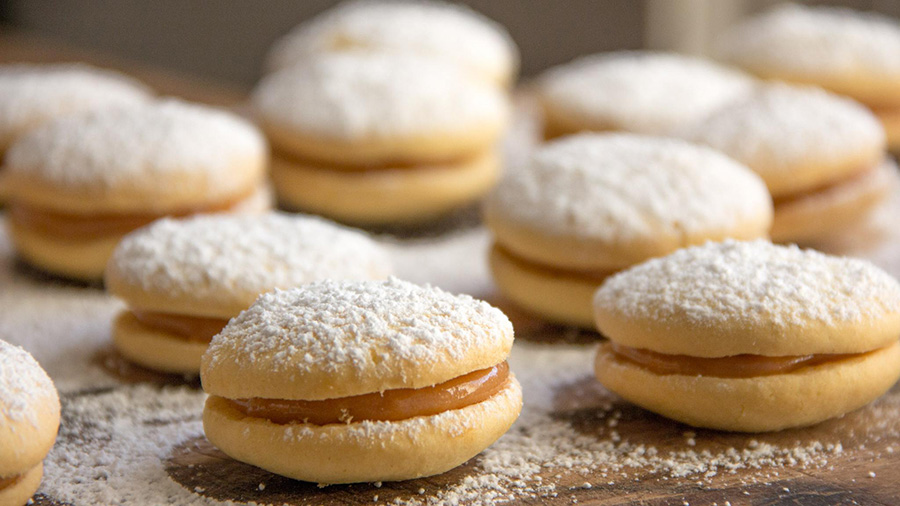Articles
The heritage of Al-Andalus in Peruvian food
Article author: Susana Bedoya Garland*
Date of publication of the article: 21/08/2021
Year of publication: 2021
Article theme: Al-Andalus, Arabic, Arabic, Culinary, History.
The Arab influence on Peruvian and other Latin American cuisine is unmistakable. Here is an overview of this heritage.
Xavier Domingo[i] states:
“Judging by the chronicles of the conquest of Peru, the cuisine of the different peoples of the Empire was healthy and probably quite similar to that of the Arab-Andalusian peoples. That is to say, a cuisine rich in fruit and vegetables and which found its proteins in the numerous fish and game”.
We deduce, like Domingo, that thanks to these similarities, the Spanish cuisine, which was generally influenced by Arabic cuisine, was quickly accepted. Several hundred Moorish men and women arrived with the first conquistadors. According to Juan José Vega’s article “Moorish and Moorish influence: three specific cases”[ii], Moorish women, called “white slaves”, were the concubines of many Spaniards and often became their wives. “These women left a special mark on the culture of the Peruvian coast”.
Some women remained in Peru and formed families with the Spanish population, such as Beatriz de Salcedo, wife of the famous traveler, and Juana Leyton, a slave adopted by Catalina Leyton, wife of Francisco Carvajal, who died in Arequipa in 1571.
Unesco’s Alcalapi project has promoted a research on Al-Andalus across the Atlantic. Camilo Álvarez de Morales[iii] points out that it should be borne in mind that the influence would not only come from medicine, but that, as a general rule, the men who came to America had lived closely with the Moorish, either because their living space was the same or because they had taken part in the frontier struggles in Granada. America thus felt the last influences of Spanish Islam.
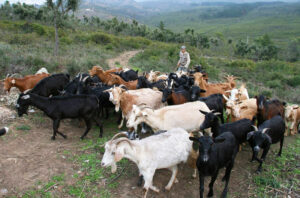 The conquistadors introduced a number of previously unknown animals, such as cows, pigs and goats. Later, chicken and rabbit. They also brought aubergine, coriander, wheat, grapes, onions, garlic, spinach, parsley, rice, beans, chickpeas, lentils, sesame, cumin, oregano; and fruits such as peaches, sultanas, almonds, oranges, bitter oranges, lemons, figs, limes, dates and sugar cane, among others. To the dishes introduced by the Spanish were added America’s native products such as potatoes, cassava, sweet potatoes, peppers, corn, etc.
The conquistadors introduced a number of previously unknown animals, such as cows, pigs and goats. Later, chicken and rabbit. They also brought aubergine, coriander, wheat, grapes, onions, garlic, spinach, parsley, rice, beans, chickpeas, lentils, sesame, cumin, oregano; and fruits such as peaches, sultanas, almonds, oranges, bitter oranges, lemons, figs, limes, dates and sugar cane, among others. To the dishes introduced by the Spanish were added America’s native products such as potatoes, cassava, sweet potatoes, peppers, corn, etc.
Savory dishes: empanadas, anticuchos and others
The conquistadors introduced the empanada, a famous starter at important events, as Mariano Valderrama points out in his book: El libro de oro de las comidas peruanas[iv]. The name “empanada” is of Arabic origin, and the recipe -of Persian origin – was introduced to Spain by the Arabs. It was prepared with a puff pastry or filo dough filled with minced meat, herbs and sultanas. In the beginning, the large pasties were filled with small poultry and various dried fruits. Examples are the famous Moroccan pastilla, which is very popular, and a similar dish that can be found in Murcia (Spain).
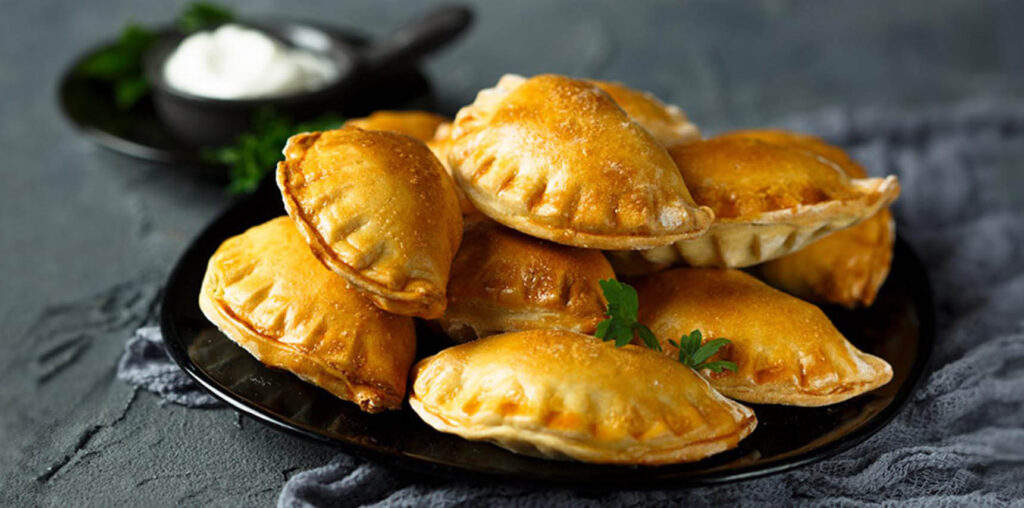
Empanadas continued to be served from the Viceroyalty period until the early years of the Republic and spread across most of the Americas. In the Andean region, chili was added, giving a special flavor to Peruvian and Bolivian empanadas. In Spain, empanadas are still made, in Galicia (north of Spain) and other regions. Empanadillas are also found in Venezuela and Mexico. In Chile they are made of pino. In Argentina and Uruguay they are made of meat. In Bolivia there are the popular salteñas, pucakapas (cheese, seasoning and chili) and llauchas con queso.
There are several versions on the origin of the Peruvian anticucho, a skewered beef heart (there is a similar dish in Bolivia). Several researchers claim that its immediate origin is Arab, as they would have spread it over the centuries on their many travels. Some believe that its origin is Persian, and that shish kebab already existed in the time of Darius, as William Thorndike points out in his book Gastronomía[v].

There are food menus from the times of the Viceroyalty, where skewers of beef heart, fish or prawns were always found. The resemblance to the Arab shish kebab is evident, although the preparation of our anticuchos also uses chili, cumin and vinegar. The last two ingredients were commonly used in Arab cuisine. I think the Spanish name pinchos morunos makes the origin clear. It is important to note that the Arabs used to eat the whole animal, including the entrails[vi]. This is portrayed in can be found in Jean Bottéro’s book La plus vieille cuisine du monde[vii], in Huici Miranda’s book[viii] and in many other works where this custom is explained. Nowadays, pinchos are eaten in Spain and Morocco and the recipes can be found in several books.
Cow or lamb tripe is another popular visceras in Arab countries; in Lima it is prepared by the cantineras.
Ceviche, escabeches, secos and aji de gallina (chicken chili)
Juan José Vega also explains that the word “seviche”[ix], written with “s” and “v”, is of Arabic origin. It comes from sibech, which means “sour dish” in Western Mediterranean Arabic. It also explains that Moorish women added bitter orange and lemon from Ceuta. In Peru, at the time of the Incas, fish was eaten marinated in chili and seaweed. Raw. References indicate that this dish was a favorite of the popular classes because it was spicy, according to Vega’s article.

Pickled fish[x], a very popular dish and a product of cultural mixing, is probably of Arab origin. The name iskebég, which became escabetx and then the name we know, escabeche. In Peru, panca pepper, green pepper and sweet potato were added to the Spanish escabeche of the time. However, there is some controversy as to whether the dish is of Roman or Arabic origin, although everything indicates that it is Arabic, according to the etymology of the term. In his book La Dieta atlántica (2009), Oscar Caballero explains it more clearly. He discusses the subject with several specialists, and after an analysis, he affirms that the dish is of Persian-Arabic origin. In this regard, I will quote Caballero when he states:
“The Spanish Academy of Language simplifies things: ‘From the ár. hisp. assukkabáǧ, and this from the ár. sikbāǧ; cf. Persian sekbā. Sauce or marinade made with fried oil, wine or vinegar, bay leaves and other ingredients, to preserve and make fish and other foods tasty”.
This is a semantic impoverishment, says Caballero, because it is actually a culinary gesture and a way of cooking.
The recipes for seco norteño de cordero, from cities like Chiclayo or Trujillo, are practically the same as those prepared in al-Andalus: white “tafaya” (seco norteño) and green “tafaya” (seco limeño).
It is fascinating to see the recipes for these stews in Huici’s book[xi], and there is even one that is practically identical. These are the ingredients: lamb meat, onions, vinegar, chopped coriander. The only thing we changed was the fermented corn chicha instead of vinegar and we added loche squash and chili. Camilo Álvarez[xii] also mentions this recipe.
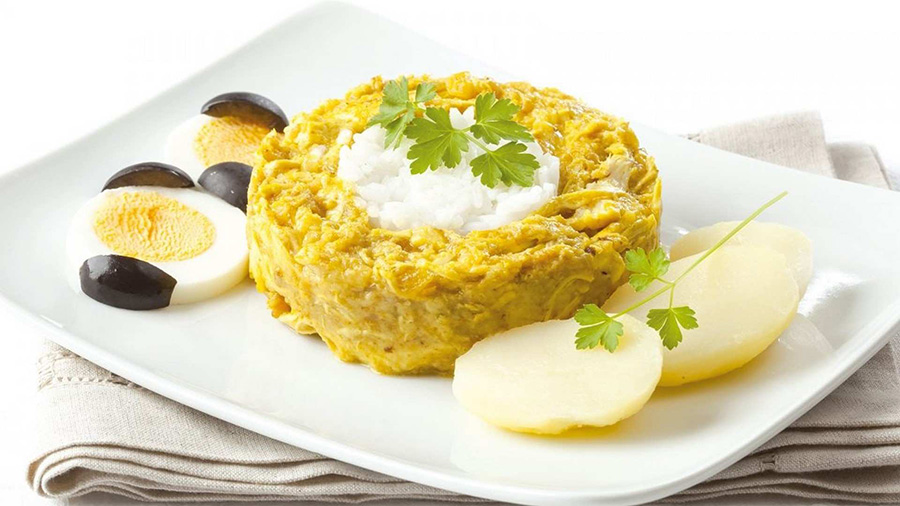
In Peru, we have a chicken-based dish mixed with breadcrumbs, ají de gallina. This dish also has an Arabic origin. Here is the original recipe:
Unleavened bread dumpling soup, called sabbai[xiii].
Use fattened hens, fattened capons and geese, pigeons, partridges, and other poultry of your choice. Put the poultry in a pan with salt, oil, pepper, coriander, and an onion cut in half. Slaughter the birds, clean and open them. Place the pan over a low heat and wait until the boiling point, then pour water until it is completely filled. Cook until its almost done. Then put them on skewers. Prepare a vinaigrette with vinegar, oil and almori, dip the birds in the sauce and cook over medium heat until it is golden brown.
Next, prepare very firm semolina cakes, making holes in them with a stick so that they cook well in the oven or on a charcoal cooker. Remove them from the heat and crumble them coarsely, about the size of a dinar. Over the stock in the pan, grate lots of good quality cheese and add plenty of garlic to add flavor. When the stock is boiling, add the unleavened bread until it absorbs all the liquid. Then put the chopped poultry meat on top and garnish with hard-boiled eggs cut with a string. Sprinkle with almonds, green and dried olives, grated cheese, cinnamon, and sarsaparilla. Eat: by the power and might of God all mighty.
What is missing? Concentrated milk, onions and chili, right? In another recipe of the same book, called shredded chicken soup, there are “chopped onions”.
Another Arab dish, more humble but no less delicious, and one that is being irretrievably lost nowadays, is migas peruanas, different from the Spanish ones and very similar to the original Arab recipe. It is a migas stew very similar to ají de gallina, with the addition of fresh cheese. In Lima, it was served with fried eggs and fried plantains. There is also miga de Arequipa, with crayfish and coral. The addition of hard-boiled or fried eggs was also a specialty of Al-Andalus.
Sweets: alfajores, turrones, figs in syrup, mazamorras, marzipans, fritters, picarones, ponderaciones
We have preserved Spanish traditions of Arab origin in sweets. Here are some Peruvian desserts of Arab influence.
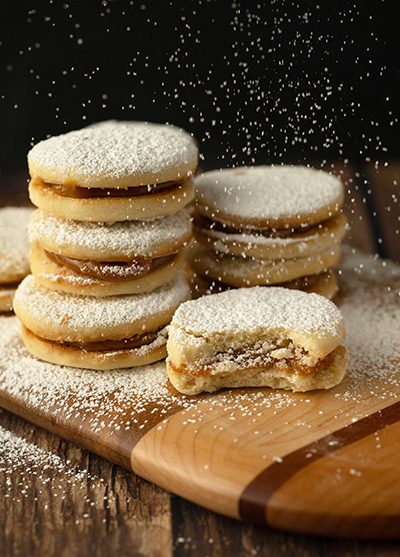 Alfajor, or alajú. “Alajú” means stuffing. It was a mixture of almond paste, walnuts and sometimes pine nuts, toasted and grated bread with fine spices and well-cooked honey. The Malaga-born Serafín Estébanez Calderón says: “Among the desserts laboriously made we find acitrón [candied cactus pulp], alajú, turrones and a thousand other sweets of Moorish origin”. In Lima, we have alfajor filled with dulce de leche and honey, or, before honey, with brown sugar, coconut and chopped nuts. The alfajor de Trujillo was very famous across Peru at the end of the 19th century, as Rosario Olivas Weston points out.
Alfajor, or alajú. “Alajú” means stuffing. It was a mixture of almond paste, walnuts and sometimes pine nuts, toasted and grated bread with fine spices and well-cooked honey. The Malaga-born Serafín Estébanez Calderón says: “Among the desserts laboriously made we find acitrón [candied cactus pulp], alajú, turrones and a thousand other sweets of Moorish origin”. In Lima, we have alfajor filled with dulce de leche and honey, or, before honey, with brown sugar, coconut and chopped nuts. The alfajor de Trujillo was very famous across Peru at the end of the 19th century, as Rosario Olivas Weston points out.
Alfajor de mil hojas. It has several layers of puff pastry filled with dulce de leche and sprinkled with icing sugar. The alfajor de volován is filled with pineapple and apricot jam and dulce de leche, and is also sprinkled with icing sugar. Alfajores are also found in Argentina. The most popular are those from Mar del Plata, filled with dulce de leche or chocolate. They are also found in Chile, Uruguay and Bolivia, where they are called alfajores de penco.
Green figs in syrup. Figs filled with dulce de leche, covered with sugar and glazed with honey. They are sold at fairs or in bakeries specializing in traditional desserts. They are found in Lima and in Mala, Cañete, Trujillo, Lambayeque and Ayacucho, where they are especially common in Easter.
Nougat (turrón). This dessert is the result of another crossbreeding. The Arabic influence is mixed with the Afro-Peruvian hands, resulting in the famous turrón de doña Pepa. To prepare the dough, a large quantity of egg yolks, sesame and aniseed is used. The filling is made with brown sugar honey, cinnamon, cloves, fig leaves, aromatic pepper, and other ingredients. In Arequipa, they prepare a turrón very similar to that from Spain.
Mazamorra morada. This dessert is made with purple corn, sweet potato flour, cloves, cinnamon, and nuts. In Peru, there are several variations, such as mazamorra with pork, honey, brown sugar, and egg yolks, among others. These mazamorras are also the result of a crossbreeding between Arab and indigenous cuisine. As chef Gloria Hinostroza points out, in Inca times they used to drink api, a type of mazamorra that was a little more liquid and made with purple corn flour. Api is still consumed in the Aymara regions and mazamorras are consumed on the coast and in the highlands.
Rice pudding[xiv]. This dessert is eaten across Peru, as well as in Spain and in several Latin American countries, with some variations: some are sweeter, with sultanas or nuts, etc.
Marzipan. The Arabs used to prepare an almond paste mixed with sugar. The current name of this dessert comes from the container where they kept the paste: “manthaban”. This popular dessert was transformed into a real pastry. It was then specially prepared by Greek nuns in a convent. They gave it the famous fruit shapes that were baked and colored with natural dyes extracted from saffron and pistachio, among others. This tradition continued in Spain and Peru, especially in the cloistered convents of La Encarnación, Santa Catalina and Santa Clara, where marzipan, manna and bolas de oro, a dessert made with a sponge cake filled with apricot jam, dulce de leche and covered with marzipan paste, were prepared.
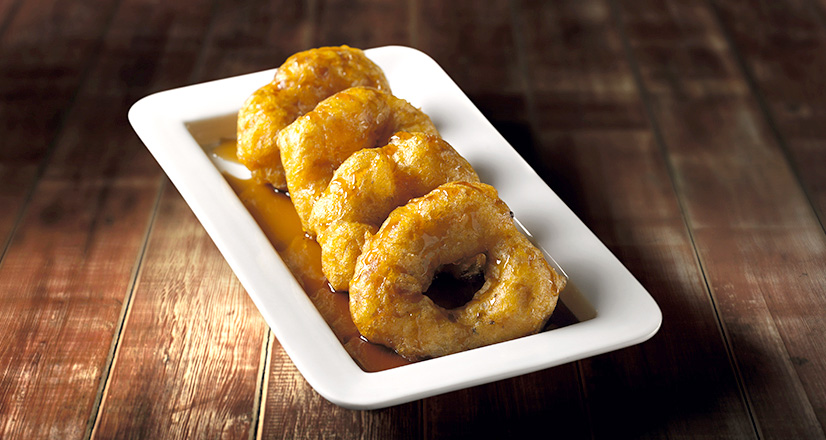
Buñuelos. Their origin is Andalusian[xv]. In Peru, they are made with a sweet potato flour dough that is fried and then dipped in sugar cane honey. The way that doughnuts are prepared, with a hole in the center and dipped in honey, is also present in Morocco, and was probably introduced by the Almohads. In Peru, this type of dessert has given rise to picarones, whose most similar recipe is the “mugaddar”[xvi]. In this regard, there is some controversy about its Roman origin. In the Maghreb, they eat doughnuts similar to ours, in the shape and even in their preparation, because the dough is taken with the hands to shape it and, with a skewer, the doughnuts are taken out of the pan and threaded. They are eaten with honey and spices, as we do, as well as with icing sugar. In several Moroccan books, there are photos showing how these fritters are prepared and how they are sold in the markets, skewered or presented on plates with icing sugar or honey.
Ponders. The dough begins glued to a patterned iron mold – quite Arabic in shape, by the way – and when fried, it falls out of the mold. Honey or icing sugar is added to the dish. In Lima, a sauce made with egg yolks is also added. In Mexico they are called buñuelos de rodilla.
Other desserts include apricots with syrup, dates stuffed with milk jam; melcocha [a kind of paste made with mallow]; ranfañote (“rafis”); almond paste; manna de convento; pan dulce, crowns; the syrups used for slushies; bienmesabe (today prepared in Spain and Latin America), and milk jam (“fadulaya”), among others.
*PhD in American History from the University Complutense of Madrid. Collaborator with the Spanish national Research Council (CSIC) and member of the Spanish Association of Americanists.
Source: Pérou, Bicentenaire 1821-2021, Embassy of Peru in Morocco.
[i] Xavier Domingo, “La cocina española antes del descubrimiento”, in Cultura, identidad y cocina del Perú, by Rosario Olivas Weston (comp.), Lima, Escuela Profesional de Turismo y Hotelería de la Universidad de San Martín de Porres, 1993.
[ii] Juan José Vega, “La influencia morisca y mora: tres casos específicos”, in Rosario Olivas Weston, op. cit. pp. 157-158.
[iii] Camilo Álvarez de Morales, “Medicina y alimentación: andalusíes y moriscos”, in Al-Ándalus: allende el Atlántico, by Mercedes García Arenal (coord.), Granada, Unesco Publishing and El Legado Andalusí, 1997.
[iv] Mariano Valderrama, El libro de oro de las comidas peruanas, Lima, Perú Reporting, 1996, p. 30.
[v] Guillermo Thorndike, Gastronomía, Lima, Universidad de San Martín de Porres, 2000.
[vi] Camilo Álvarez de Morales, op. cit., p. 155.
[vii] Jean Bottéro, La plus vieille cuisine du monde, Barcelona, Tusquets Editores S. A, 2005.
[viii] Hispano-Maghrebi cuisine at the time of the Almohads, according to a 13th century manuscript.
[ix] The National Institute of Culture, by means of National Directorial Resolution 241/INC of 23 March 2004, declared this dish a National Cultural Heritage. This resolution also indicates that the correct and historical spelling is “seviche”, which shows the Moorish influence on Peruvian cuisine. In this regard, there are disputes over the spelling in the Peruvian Academy of Language.
[x] Camilo Álvarez de Morales, op.cit, p. 155.
[xi] Jean Bottéro op. cit.
[xii] Camilo Álvarez de Morales op. cit. p. 155.
[xiii] Ibn Razin al Tugibi, Relieves de las mesas, acerca de las delicias de la comida y los diferentes platos, study, translation and notes by Manuela Marín, Madrid, Ediciones Trea, 2007, p. 87.
[xiv] La cocina hispano-magrebí, durante la época almohade, según un manuscrito anónimo del siglo XIII, translated by Antonio Huici Miranda, Asturias, Ediciones.
[xv] Preparation of wind fritters, daggerboard, almojábanas [fritters made with cheese and flour]: in Ibn Razin al Tugibi, op. cit.
[xvi] Ibn Razin al-Tugibi, op. cit., pp. 124-125.


